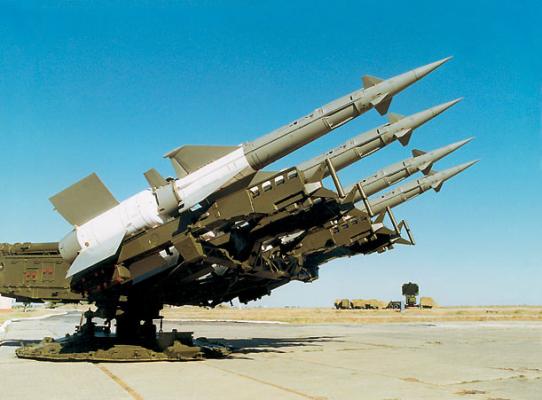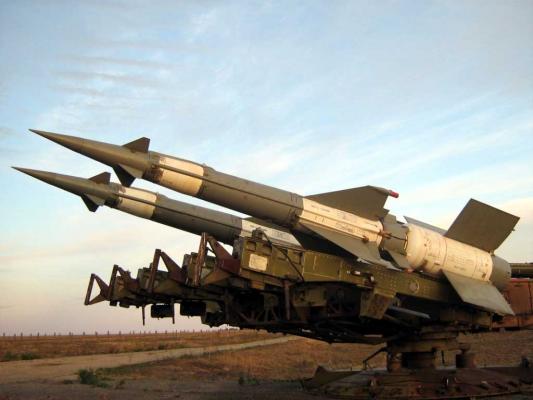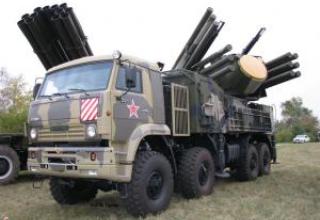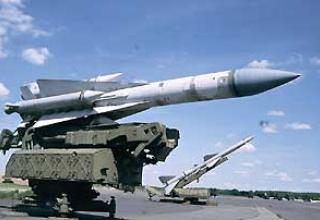S-125M SAM system is designed to protect the most important administrative, industrial and military facilities from all types of air attacks, flying at extremely low and medium altitudes. It provides destruction of bombers, fighter-bombers, multipurpose aircraft and cruise missiles with effective scattering surface of 0.2m2 and more.
Development of SAMs C-125 began in 1956 in KB-1 (NPO "Almaz") in response to the emergence of aircraft capable of operating effectively at low and extremely low altitudes. The specifications for the development of this complex provided for the possibility of destroying targets flying at altitudes from 200m to 5km and ranges from 6km to 10km with speeds up to 420 m/s (1500 km/h). After the first tests of the complex with 5B24 missile, there was an addition to the technical specifications on the SAM system. They introduced a new missile 5B27, unified with the marine SAM system "Wave". At the same time, the system's tactical and technical characteristics (TTH) were significantly improved.
In 1961 the complex was adopted for service and received the designation C-125 "Neva".
Later the complex was repeatedly upgraded. In its structure there were additionally introduced: equipment of TV channel of target sighting, equipment of GSP interference control, equipment of remote indicator of SRC, equipment of distraction of PRR "Dupler", identification equipment, equipment of sound control of target. The complex could fire ground and surface targets at ranges up to 17 km.
The upgraded version of the C-125M "Neva-M" complex was adopted for service in 1964. The export version received the designation C-125 "Pechora". Supplies of S-125 SAM systems to the countries of the Warsaw Pact began in 1969, and a year later to other countries as well. Among them: Afghanistan, Angola, Algeria, Bulgaria, Cuba, Czech Republic, Egypt, Ethiopia, Finland, Hungary, India, Iraq, Korea, Libya, Mali, Mozambique, Peru, Poland, Syria, Tanzania, Vietnam, Yemen, Yugoslavia.
The last attempt to modernize the C-125 SAM system took place in 1980, when it was proposed to transfer the missile guidance station to a digital element base, to decouple the missile and target channels by introducing two control posts (which allowed the introduction of the "full preemptive" method to increase the long range of the kill zone to 42 km) and to introduce the missile's homing channel. These proposals were rejected for fear that the upgraded C-125 would prevent the S-300P SAM system from starting production.
At present, it is proposed to upgrade the complex, designated S-125-2 "Pechora-2".
In the west, the C-125M complex was designated SA-3b "GOA".
Composition:
The system includes an anti-aircraft missile system (SAM), 5B24 or 5B27 antiaircraft guided missiles (ALCM) and technical support facilities.
SAMs include the following fixed assets.
- the SNR125M radar tracking and pointing station, placed on two trailers (the control cabin of the UNK and the UNV antenna post); the SNR 125M has radar and TV tracking channels, working in automatic and manual modes. The station is equipped with an automated device for launching missiles APP-125 designed to determine the boundaries of the zone of engagement of air defense systems, solving the problem of launching and determining the coordinates of the meeting point of the target and the missile.
- missile battery, which includes 4 launchers 5P73 with four missiles each;
- a power supply system, including a distribution cabin and a diesel-electric station. It is possible to connect to industrial networks.
The complex is single-channel by target and two-channel by missile. Two missiles can be pointed at the target simultaneously.
In addition, radar detection and target designation facilities can be provided for P-12 and P-15 radars. SAMs are placed in transported trailers and semi-trailers, and communication between them is carried out via cable.
The complex task of creating a low-altitude SAM system required non-trivial technical solutions. This, in particular, is the reason for the unusual appearance of the UNV SNR-125 antenna device (see photo).
To hit a target flying at an altitude of 200m at a speed of 420m/s at the turn of 10 km, it is necessary to launch the missile when the target is at a distance of 17 km, and capture the target for auto tracking (AC) at a distance of 24 km. Then the detection range of such a low-altitude target should reach (taking into account the time for additional search) 32-35 km. In this case, the angle of target location when detecting is only about 0.3°, and when capturing it on the AU - 0.5°. At such small angles of position the value of the radar signal reflected from the ground by the missile guidance station exceeds the value of the signal reflected from the target. To reduce this effect, two antenna systems are included in C-125. One is non-scanning, receiving and transmitting, the other is scanning, receiving. When working at low altitudes, the transmitting antenna is set to 1°. In this case, the transmitter irradiates the ground only by the side blades of the antenna's directional pattern, which reduces the signal reflected from the ground by tens of times. To reduce the target tracking error associated with the so-called "mirror reflection", which is the interference of the direct and re-reflected target signals from the ground, the receiving antennas of both planes of view are rotated with respect to the horizon by 45°. This predetermined the characteristic view of the antenna post of "Pechora" SAM system.
Another challenge related to the low altitude of the target flight was the creation of Moving Target Detector Equipment (MTS), which effectively emits the target signal against the background of powerful ground reflections and passive interference. It was also the first time that a periodical subtraction device on solid ultrasonic delay lines (SDRs) was developed. The characteristics of this SDC far exceeded those of all existing pulsed radiation radars. The suppression of passive interference and reflections from stationary objects was up to 33:36 dB. In order to stabilize the pulse repetition period of the sounding pulses, the SNR synchronizer was tuned to the delay line of the SLC. Later on, this was a disadvantage of the station, as it did not allow to arbitrarily change the repetition frequency to be adjusted from the synchronous pulse interference. To combat active interference, a system of frequency jump of the transmitter when the interference exceeds the specified level was provided.
ZUR 5B27 (B-601, 4K91) is a two-stage, aerodynamic scheme "duck" (see diagram). The first stage is a solid fuel accelerator with four stabilizers mounted on it that can be opened after the start and two aerodynamic surfaces on the transition connecting compartment that provide for reduction of the accelerator flight range after separation. After separation of the steps, these surfaces were deployed, resulting in intense rotation and braking of the Accelerator with all or more stabiliser consoles removed and the Accelerator dropped randomly. The second stage of the missile was also equipped with a solid propulsion system. Structurally, the second stage consists of a number of compartments, which are located in the radio detonator, rocket rudder control units, shrapnel and high-explosive warhead, units of onboard equipment, solid rocket engine, receivers control commands.
The missile's flight and targeting are controlled by radio commands from the ground-based guidance radar, while the detonation of a combat unit is carried out on command from a radio detonator when approaching the target at the required distance or from a guidance station. The operating time of the starting accelerator was 2 ... 4 seconds, and that of the marching engine was up to 20 seconds. To increase the range, the ZUR was also guided on the passive section of the trajectory, the self-liquidation time was 49 sec. The rocket performs a maneuver with an overload to 6 units. The temperature range of operation is from - 40° to +50°.
Simultaneously with the adoption of the missile B-601P began work on the expansion of combat capabilities of the SAM system, including to ensure the firing of targets at speeds up to 2500 km / h, firing at circumaural targets at altitudes up to 18 km, increasing the probability of hitting targets and increase interference immunity.
The following missile modifications have been developed:
- 5B27G - airtight;
- 5B27GP - hermetically sealed, with shortened to 2.7 km the close border of the kill zone;
- 5B27GPS - hermetically sealed, with an approximate near-range kill zone boundary, with a selective block, which reduced the probability of the radio detonator on reflections from local objects when shooting at low-flying targets;
- 5B27GPU - 5B27GP rocket with accelerated prelaunch preparation, which was achieved by applying high voltage to the on-board equipment from the ground power supply in the prelaunch heating mode of the equipment (the equipment of prelaunch preparation in the cabin of the UNK).
B-601 missiles of all modifications were produced by Kirov plant #32. Dimensional weighting mock-ups of missiles, training and cutting mock-ups of missiles were produced for education and training of personnel.
Launch of the rocket - inclined, with 5P73 launcher (see diagram), guided by the angle of the place and azimuth. The transported four-bar 5П73 (SM-106) launcher was designed by the Chief Designer B.S.Korobov. The launcher without gas reflectors and running gear was transported by YAZ-214 vehicle. When shooting at low-altitude targets, the minimum launch angle of the rocket was 9°. To prevent soil erosion during rocket launches, a special rubber-metal multi-section circular coating was laid around the PU. Charging of the launcher was carried out sequentially by two transport and charging machines on the basis of the vehicle cross-country ability ZIL-131 or ZIL-157.
To ensure power supply from the industrial network, a mobile transformer substation mounted in the body of a two-axle car trailer was used. The reconnaissance and target designation stations P-12NM (P-18) and P-15 assigned to the C-125 divisions were equipped with their own autonomous power supplies AD-10-T/230MAB-8-0/230M and AB-4-T/230M.
State ownership of the aircraft was determined by the Ground Radar Requestors (NRZ) "Password-3P" (75E6) or "Password-4P" (1L22) assigned to the division.
In the early seventies, the C-125M complex was upgraded in terms of improving radioelectronic equipment, which increased the interference immunity of target sighting and missile control channels. Introduction of TV-optical sighting and target tracking equipment "Karat-2". (9 SHZA) it was possible to visually follow and fire the target without radar into space. In this case, the target channel transmitter switched to the antenna equivalent placed on the antenna post. It was significantly easier to work with interference planes in visual visibility. However, the optical channel of target sighting lost its effectiveness in bad weather and cloudy conditions, as well as when observing towards the sun or to an impulse light source set by an attacking aircraft. In addition, TV optical sighting did not provide information about the distance to the target, which limited the choice of guidance methods and significantly reduced the effectiveness of shooting at high-speed targets.
In the second half of the seventies, the SAM system introduced equipment that increased the effectiveness of its use against targets at extremely low altitudes and when shooting at ground and surface targets. Besides, a new modification of SAM 5B27D with increased flight speed was created, which made it possible to introduce "inhalation" firing of targets. The length of the SAM was increased, its mass increased to 980 kg with the mass of the launch accelerator - 407 kg. But for heavier 5B27D only 3 missiles were allowed to charge 5P73 PU. C-125M1 complex with 5B27D rocket was adopted for service on May 3, 1978.
Characteristics:
| Defeat zones | ||
| Altitude range, km | 0.02-18 | |
| Maximum range, km: - at an altitude of 0.5km - at an altitude of 6 km - at an altitude of 14-20 km |
11 17 18 |
|
| Maximum parameter,km | 16 | |
| Probability of hitting the target with one missile at a range of 25 km. | 0.5 | |
| Noise immunity characteristics | ||
| Interference that takes you around the corner: - escort angular errors (with GSN) - escort angles (without GSN) |
2'-3' 5'-10' |
|
| Breeding of moving targets: - Angular target tracking errors due to reflections from local objects and passive interferences - angular targeting errors in "MW" - rollover of target tracking against the background of reflections from local objects - work in ACP on background DNA (Rn=100km), W/MHz |
3'-5' till 10' no 100 |
|
| Target auto capture time on AC,s | 8 | |
| Starting device | ||
| operational mode | semi-automatic machine | |
| data production time,s | 7 | |
| point of encounter accuracy,km | 1.5-3.0 | |
| Distance between the control cabin and the center position, m | till 20 | |
| Distance from PU to control cabin, km | till 0.07 | |
| 5B27 missile | ||
| Length, mm | 5948 | |
| Diameter of the first stage, mm | 552 | |
| Diameter of the second stage, mm | 379 | |
| Start weight, kg | 980 | |
| Flight Speed, m/s | till 730 | |
| Maximum target speed, m/s | 700 | |
| Weight BC, kg | 72 | |
Testing:
C-125 complex was used in various local wars and conflicts.
In 1970, 40 divisions of C-125 with Soviet personnel arrived in Egypt, where they quickly showed their effectiveness. Between July and August 1970, 9 Israeli planes were shot down in 16 firings and 3 were damaged, after which a ceasefire in Suez was reached.
The last case of S-125 SAM system combat use took place in 1999 during the NATO aggression against Yugoslavia. By the time the air defense operations in Yugoslavia began, 14 S-125 batteries with 60 launchers with 4 guides each had been installed. Some of them were upgraded by installing a thermal imaging camera and laser rangefinder in the fire control system, which ensured the launch of the missile without prior designation from SNR-125. However, in general, the effectiveness of the Yugoslav air defense system was undermined by the "aging" of the missiles and their irregular maintenance. The remaining service life of most, if not all, S-125 missiles was equal to zero. NATO's electronic countermeasures proved to be sufficiently effective against the obsolete S-125. The Divisions were seriously damaged, but of the 8 S-125 SPADS located around Belgrade, which were the most heavily attacked, the 2 Divisions still remained combat-ready until the end of the conflict. In order to reduce losses, the tactics of the "Neva" divisions were based on the use of their radar only for a short time (23-25 seconds), calculated by the headquarters on the results of the first losses caused by the "HARM" anti-radar missiles. Calculations of the complexes mastered the hidden maneuver with constant movement from position to position and firing "from ambush". As a result, it was the C-125 that was shot down by the American F-117 fighter-bomber.
Sources:
- "Новые возможности ЗРК 'Печора'". Рекламный проспект ФПГ "Оборонительные системы"
- В. Зацепин, В. Кудрявцев "С-300 дает новую жизнь "Печоре""
- Рост угрозы со стороны ЗРК: Уроки Косово
- Уроки балканской войны
- С.Ганин, В.Коровин, А.Карпенко, Р.Ангельский. Ракетные комплексы ПВО страны. Авиация и Космонавтика, №12, 2002
- М.Первов "Зенитное ракетное оружие противовоздушной обороны страны", Москва, Авиарус-XXI, 2001








